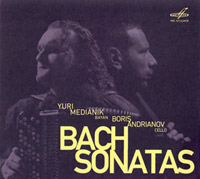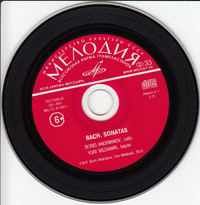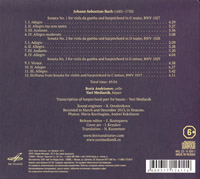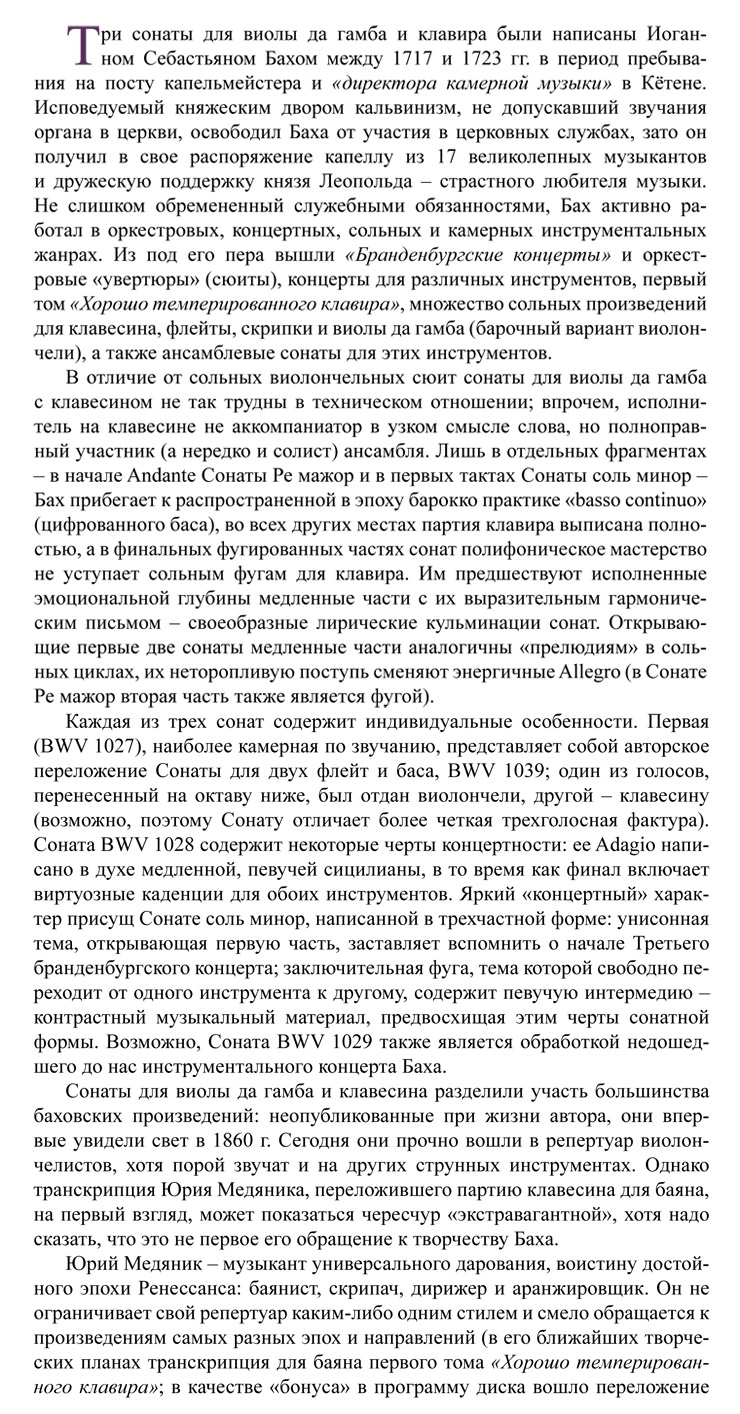| YMCD004eT: Bach Sonatas eTracks (mp3) Album by Yuri Medianik & Boris Andrianov |
| |
Name (Click for Sound Sample) |
Composer |
Time |
Buy/Price |
| |
Sonata No. 1 for viola da gamba and harpsichord in G major, BWV 1027 |
| 1. |
I. Adagio |
J S Bach |
4:29 |
€0,90 |
| 2. |
II. Allegro ma non tanto |
J S Bach |
3:27 |
€0,90 |
| 3. |
III. Andante |
J S Bach |
3:36 |
€0,90 |
| 4. |
IV. Allegro moderato |
J S Bach |
3:08 |
€0,90 |
| |
Sonata No. 2 in D Major for Viola da Gamba and Harpsichord in D Major, BWV 1028 |
| 5. |
I. Adagio |
J S Bach |
2:09 |
€0,90 |
| 6. |
II. Allegro |
J S Bach |
3:28 |
€0,90 |
| 7. |
III. Andante |
J S Bach |
5:20 |
€1,25 |
| 8. |
IV. Allegro |
J S Bach |
4:04 |
€0,90 |
| |
Sonata No. 3 in G Minor for Viola da Gamba and Harpsichord in G minor, BWV 1029 |
| 9. |
I. Vivace |
J S Bach |
4:58 |
€0,90 |
| 10. |
II. Adagio |
J S Bach |
6:27 |
€1,25 |
| 11. |
III. Allegro |
J S Bach |
3:42 |
€0,90 |
| 12. |
Siciliana from Sonata No. 4 in C Minor for Violin and Harpsichord in C minor BWV 1017, J S Bach |
4:11 |
€0,90 |
| YMCD004: Bach Sonatas eTracks CD by Yuri Medianik & Boris Andrianov |
 |
 |
 |
Order
CD by credit card, Euro 15 or US$ equivalent plus postage,
using our secure server bank system
Euro Order US$
Order |
 Description: Description: |
Bach Sonatas |
Johann Sebastian Bach wrote three Sonatas for viola da gamba and
harpsichord within 1717 and 1723 when he served as kapellmeister and
director of chamber music in Köthen.
Calvinism professed by Prince Leopold did
not allow organ music in church thus exempting Bach from attending the divine
services. Instead, he got at his disposal a choir of seventeen splendid musicians
and amiable support from the prince who was an ardent lover of music.
Bach was
not too burdened with service duties and actively worked in orchestral, concerto,
solo and chamber instrumental genres. So, he penned the Brandenburg Concertos
and orchestral “overtures” (suites), concertos for various instruments, the initial
volume of the Well-Tempered Clavier, numerous solo pieces for harpsichord,
flute, violin and viola da gamba (a baroque version of the cello) and ensemble
sonatas for these instruments.
Unlike the solo cello suites, the sonatas for viola da gamba and harpsichord are not
that complicated in terms of technique; although the harpsichord player is not an accompanist in the narrow sense of the word but a full participant (and sometimes a soloist) of the ensemble. Bach resorts to the practice of basso continuo (figured bass) only in some fragments – in the beginning of Andante of the D major sonata and in the first
bars of the G minor one. In all other places the harpsichord part is fully written out,
while the polyphonic properties in the final fugued movements of the sonatas are not
inferior to the fugues for solo harpsichord.
They are preceded with deeply emotional
slow movements with their expressive depth of harmonic writing – peculiar lyrical
culminations of the sonatas. The slow movements that open the first two sonatas are
similar to the “preludes” in the solo cycles. Their unhurried pace gives way to energetic
Allegro (the second movement in the D major sonata is also a fugue).
Each of the three sonatas has its individual features. The sound of the first one
(BWV 1027) has more chamber qualities than the others. It is the composer’s transposition
of the Sonata for two flutes and bass, BWV 1039, with one of the voice taken an
octave lower given to the cello and the other to the harpsichord (that is perhaps why the sonata is distinguished through a clearer three-part texture).
Sonata BWV 1028 has
some features of concerto: its Adagio is written in the vein of a slow, melodious siciliana,
while the finale comprises virtuosic cadenzas for both instruments. The G minor
sonata written in a three-movement form possesses a bright “concerto” nature: a unison
theme that opens the first movement makes us recollect the beginning of the third
Brandenburg Concerto; the final fugue with a theme freely moving from one instrument
to the other contains a melodious interlude – a contrasting musical material, thus anticipating
the features of sonata form.
Sonata BWV 1029 might also be an arrangement
of Bach’s unknown instrumental concerto.
The sonatas for viola da gamba and harpsichord shared the fate of most of Bach’s
works – unpublished in the composer’s lifetime, they first saw the light of day in 1860.
Today they are integral parts of the cellists’ repertoire although they are at times played
on the other stringed instruments as well. However, the transcription made by Yuri Medianik
who arranged the harpsichord part for the bayan may seem overly eccentric
at first glance, but we should also say that it is not the first time he turns to Bach’s music.
Yuri Medianik is a versatile talent, the kind that could be found in the Renaissance.
A bayanist/accordionist, violinist, conductor and arranger, he does not limit his repertoire to any one
style venturing upon works of very different periods and directions (a transcription
of the first volume of The Well-Tempered Clavier for bayan is among his nearest plans;
an arrangement of Largo from the C minor violin sonata, BWV 1017, comes as a
bonus on this album). A top class performer, he showcases in his renditions the capabilities
of the bayan as an academic concert instrument with a very broad virtuosic and
timbre palette that ranges far beyond its too popular folklore role.
The timbre likeness of the two instruments that may seem unexpected at first sight
(bayan/cello ensemble arose interest from a number of domestic and foreign composers
in the recent years) leads to the effect of homogenous and harmonious coupling
that allows a listener to plunge into contemplation of the polyphonic lace of Bach’s
part leading, into mystical beauty of the harmony of the last movements. This arrangement has attracted attention of some musicians, but it appears on CD for the first time.
An ensemble of two remarkable musicians comprised of Yuri Medianik and cellist
Boris Andrianov, a brilliant representative of Natalia Shakhovskaya’s school and
the only Russian prize-winner of the International Rostropovich Cello Competition
in Paris, will indeed give the new interpretation of Bach’s cello sonatas a start in life
among the professionals and a broad circle of music lovers alike. |
 |

|
|
Order
CD by credit card in Euro or US$, using our secure server bank system
Euro
Order US$
Order |
Click Index Page to view Medianik CV and information about other recordings. |
|